Unveiling the Mysteries of Guangsheng Temple: A Spiritual Retreat
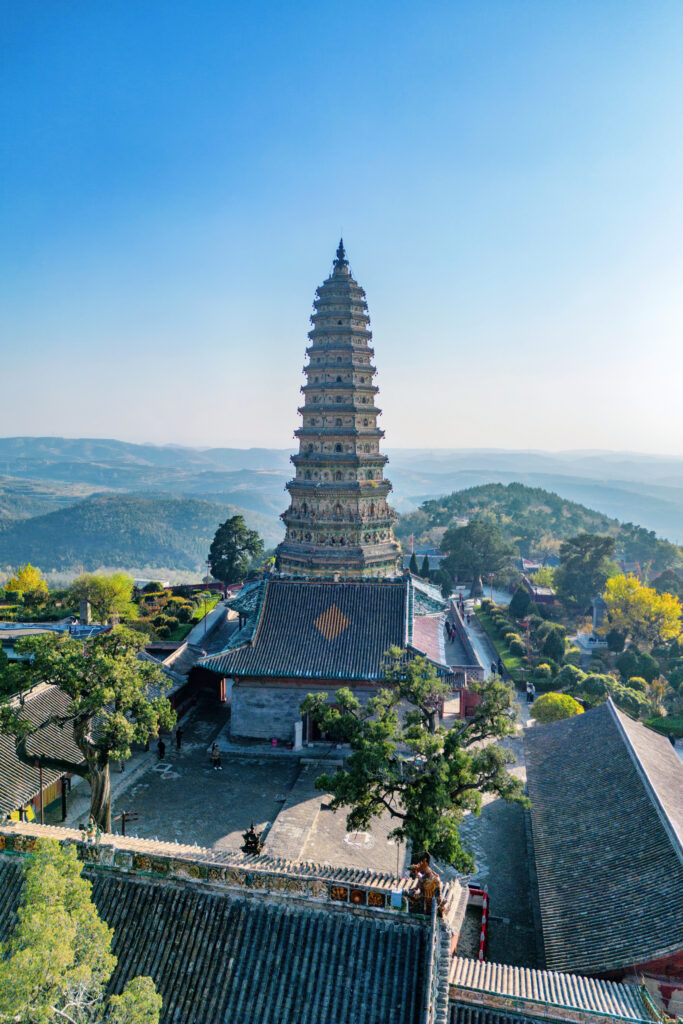
An Essential Guide to Visiting Guangsheng Temple
In This Guide
- An Essential Guide to Visiting Guangsheng Temple
- The Rich History and Legends of Guangsheng Temple
- Main Highlights: What You Absolutely Can’t Miss
- Planning Your Visit: A Practical Guide
- Tickets: Prices, Booking, and Tips
- How to Get There: A Complete Transportation Guide
- Local Cuisine and Accommodation Nearby
- Frequently Asked Questions
- Final Thoughts on Your Trip
Nestled at the foothills of Huoshan Mountain in Shanxi Province, Guangsheng Temple (广胜寺) stands as a testament to the rich tapestry of Chinese Buddhist heritage and architectural brilliance. Established during the Eastern Han Dynasty in 147 AD, this remarkable temple complex is not just a spiritual sanctuary but a treasure trove of history, culture, and art. As you step into its serene grounds, you’ll find yourself transported to a world where ancient traditions and exquisite craftsmanship converge.
Highlights of Guangsheng Temple
-
Feihong Pagoda: The crown jewel of Guangsheng Temple is the stunning Feihong Pagoda, renowned as the largest and best-preserved glazed pagoda in China. Standing at an impressive 13 stories, this octagonal marvel glimmers in the sunlight, showcasing intricate designs that reflect the artistic ingenuity of the Ming Dynasty.
-
Exquisite Murals: Venture inside the pagoda to discover vibrant murals that narrate Buddhist tales and local folklore. These vivid artworks are not only visually striking but also represent an essential part of ancient Chinese mural art.
-
Architectural Splendor: The temple complex is divided into two main sections— the Upper Temple, where the Feihong Pagoda is located, and the Lower Temple, known for its Great Hall adorned with exquisite Buddha statues. The architecture represents a harmonious blend of styles from the Yuan, Ming, and Qing dynasties.
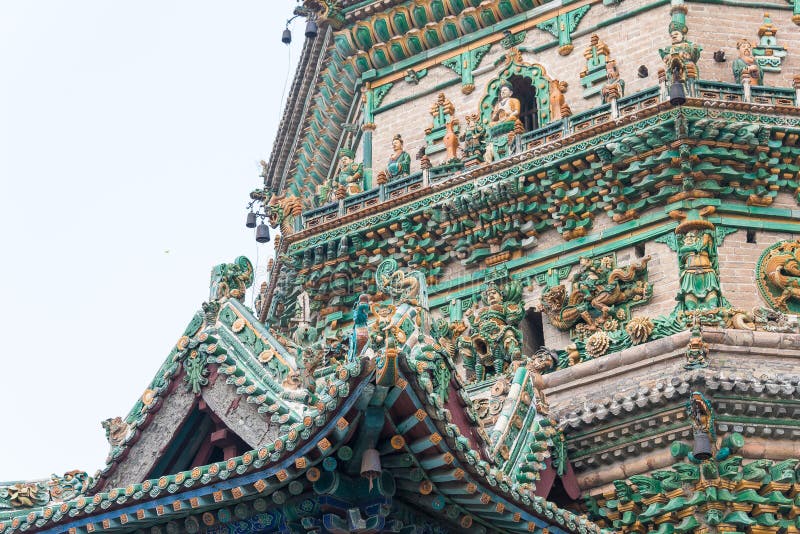
Guangsheng Temple.
Visitor Experience
Guangsheng Temple is more than just a site for sightseeing; it offers visitors a chance to immerse themselves in Buddhist culture. Participate in Zen meditation sessions, which provide a unique opportunity to experience tranquility and mindfulness amid the temple’s serene surroundings.
Practical Information
-
Location: Located 17 kilometers northeast of Hongdong County, Guangsheng Temple is easily accessible yet feels like a hidden gem, perfect for those seeking a quieter escape from the more tourist-heavy areas.
-
Opening Hours: The temple is open daily from 7:00 AM to 7:00 PM, allowing ample time for exploration.
-
Suggested Visit Duration: Allocate 2-3 hours to fully appreciate the temple’s beauty and participate in activities.
-
Admission Fee: The entrance fee is approximately HKD 9.52, making it an affordable destination for travelers.
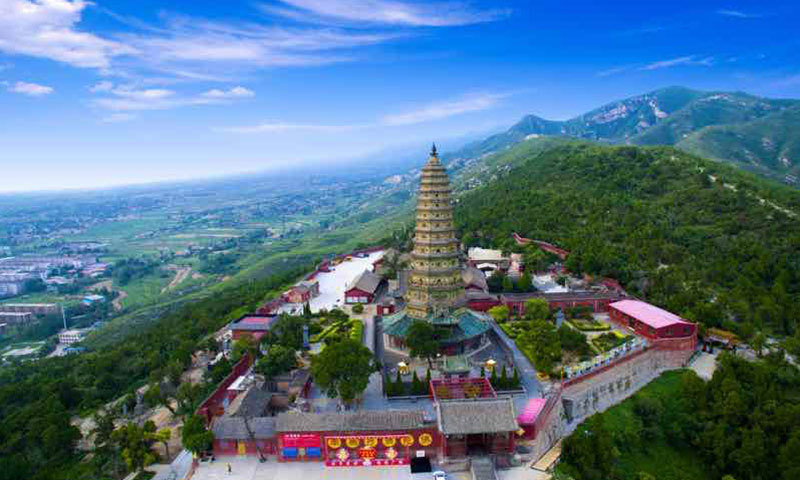
Guangsheng Temple.
Getting There
To reach Guangsheng Temple, visitors can take a local coach or drive. If you prefer a more leisurely approach, small cars are available for hire to take you directly to the temple’s doorstep, eliminating the short hike required for those arriving by coach.
Conclusion
Whether you are an avid history buff, a lover of architecture, or simply in search of a peaceful retreat, Guangsheng Temple promises an enriching experience. As one of China’s key cultural relics, it beckons you to explore its storied past and vibrant present, offering a glimpse into the enduring legacy of Chinese Buddhism. Don’t miss the chance to discover this hidden gem, where every corner whispers tales of ancient wisdom and artistry.
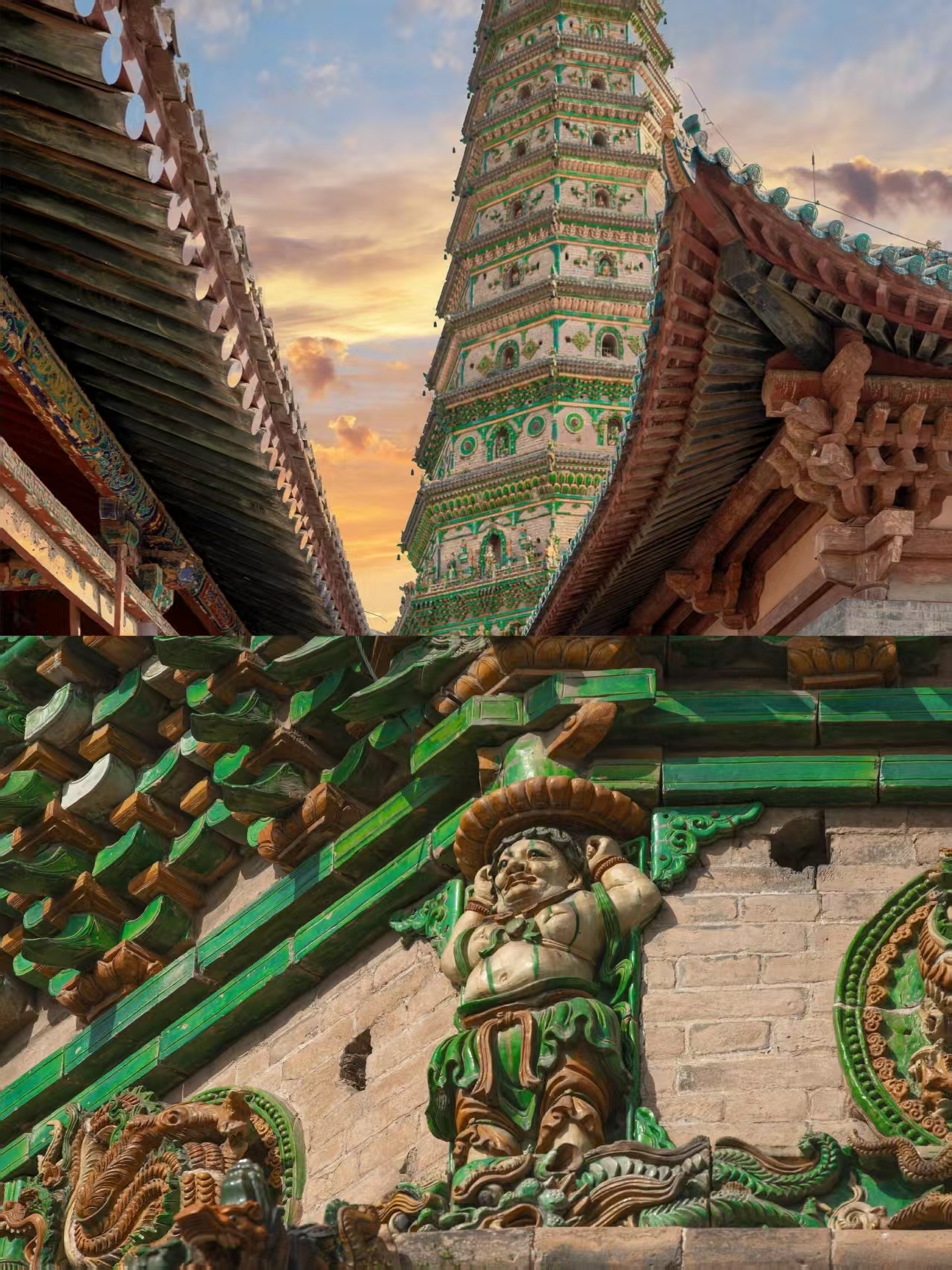
Guangsheng Temple.
The Rich History and Legends of Guangsheng Temple
Guangsheng Temple, nestled at the foot of Huoshan Mountain in Shanxi Province, is an architectural and cultural gem that has captivated visitors for centuries. Its rich history and the legends that surround it create a fascinating narrative that enhances the temple’s allure.
A Historical Overview
Established in 147 AD during the Eastern Han Dynasty, Guangsheng Temple has undergone numerous renovations and expansions throughout various dynasties, including the Yuan, Ming, and Qing. This extensive history has allowed it to evolve into a significant Buddhist cultural site, serving as a key relic protection unit in China. The temple complex is divided into two parts: the Upper Temple, which sits atop Huoshan Mountain, and the Lower Temple, located at its base. The Feihong Pagoda—the highlight of the Upper Temple—is renowned as the largest and most well-preserved glazed pagoda in China, standing proudly as a testament to the architectural prowess of ancient Chinese builders.
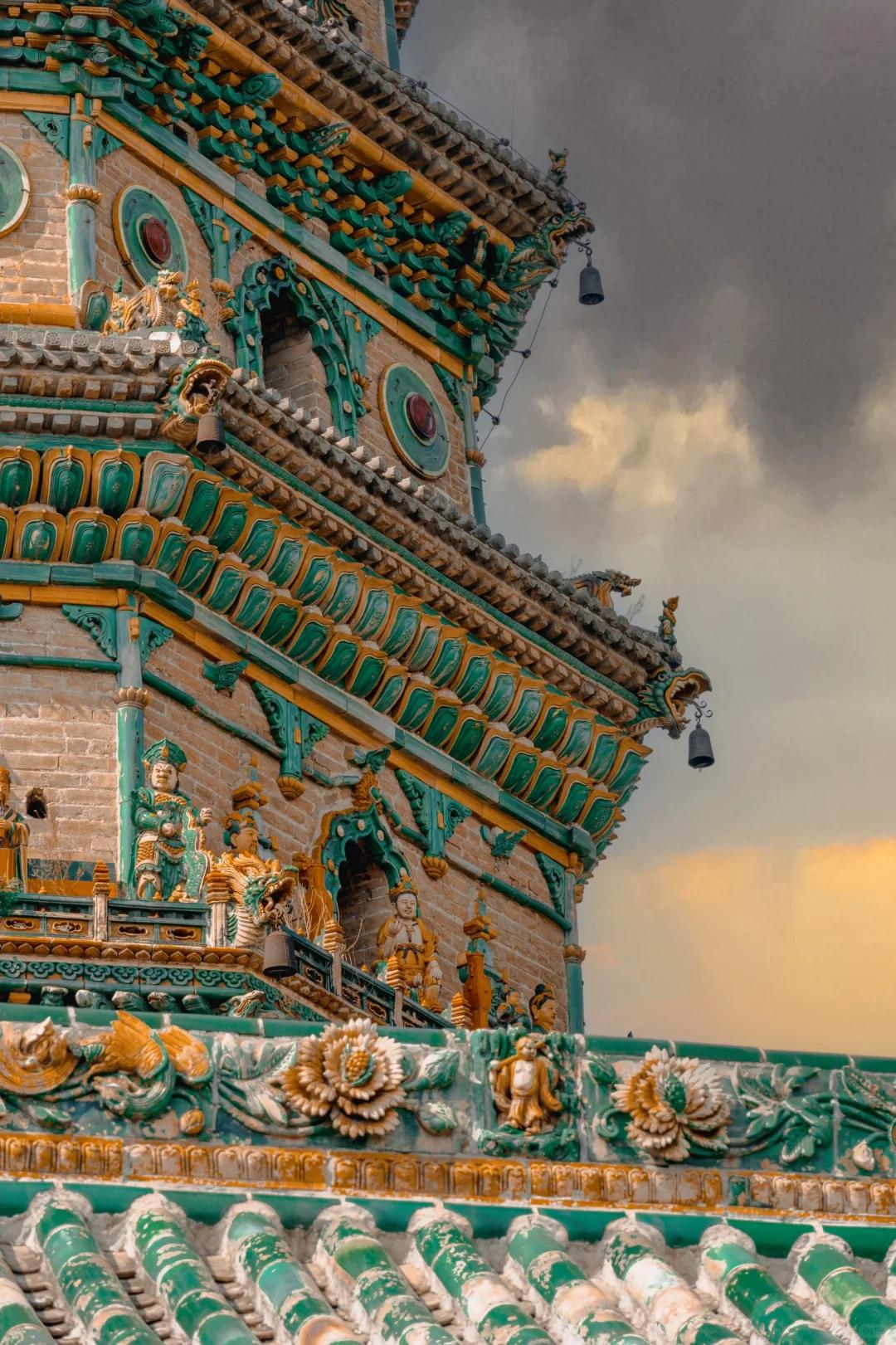
Guangsheng Temple.
Architectural Marvels
The Feihong Pagoda, an octagonal structure with 13 storeys, glimmers in the sunlight, its colorful glazes creating a stunning visual spectacle. The pagoda is not just an architectural wonder; it is adorned with exquisite murals that showcase Buddhist stories and local customs, providing a vibrant glimpse into the cultural tapestry of the time. The Lower Temple features the Great Hall, which houses intricate Buddha statues and serves as a focal point for worshippers and tourists alike.
Legends and Cultural Significance
Guangsheng Temple is steeped in legends that add to its mystique. One popular tale speaks of a monk who once meditated in the temple, achieving enlightenment and saving the local villagers from calamities. Following this event, the temple became a revered site for spiritual seekers, and its reputation as a place of healing and peace spread far and wide.
Moreover, the temple is often associated with the practice of Zen meditation, allowing visitors to engage in personal reflection while surrounded by the serene beauty of its ancient architecture. This blend of spirituality and artistry provides a unique experience for those seeking to understand and appreciate the depths of Chinese Buddhist culture.

Guangsheng Temple.
A Potential UNESCO World Heritage Site
With its historical significance, architectural beauty, and cultural richness, Guangsheng Temple has been proposed as a candidate for UNESCO World Heritage status. As it stands today, it offers an immersive experience that intertwines history, spirituality, and artistry. Visitors are encouraged to explore the temple’s grounds, participate in Buddhist cultural activities, and soak in the tranquility that this sacred space imparts.
Visitor Experience
For international travelers, Guangsheng Temple is more than just a historical site; it is a journey into the heart of Chinese culture. Whether you are drawn by the allure of the Feihong Pagoda, the serenity of the temple grounds, or the legends that echo through its halls, Guangsheng Temple promises a rich and memorable experience.
As you explore this magnificent temple, take a moment to reflect on the lives of those who walked these paths before you, connecting the past with the present in this enchanting corner of Shanxi Province.

Guangsheng Temple.
Main Highlights: What You Absolutely Can’t Miss
Discover the Splendor of Guangsheng Temple
Nestled at the foot of the majestic Huoshan Mountain in Shanxi Province, Guangsheng Temple (广胜寺) is a treasure trove of history and culture that beckons to international travelers. This stunning Buddhist sanctuary, originally built in the year 147, is one of the oldest and most significant religious sites in the region. Here’s what you absolutely cannot miss during your visit.
1. Feihong Pagoda: A Glimmering Marvel
The crown jewel of Guangsheng Temple is undoubtedly the Feihong Pagoda, known as the “Flying Rainbow” tower. This octagonal structure stands 13 stories tall and is the largest and best-preserved glazed pagoda in China. With its vibrant colors shining brilliantly under the sun, the pagoda is a breathtaking sight that embodies the exquisite craftsmanship of ancient Chinese architecture. Make sure to capture its grandeur from various angles, particularly from the base where the intricate details come to life.
2. Rich Architectural Heritage
As you explore the temple grounds, take the time to appreciate the architectural styles that have evolved over centuries. The existing structures date back primarily to the Yuan, Ming, and Qing dynasties. Each building showcases unique elements of Buddhist architecture, making it a valuable site for historians and architecture aficionados alike. Don’t miss the exquisite colored glaze buildings from the Yuan Dynasty, which highlight the advanced construction techniques of the time.
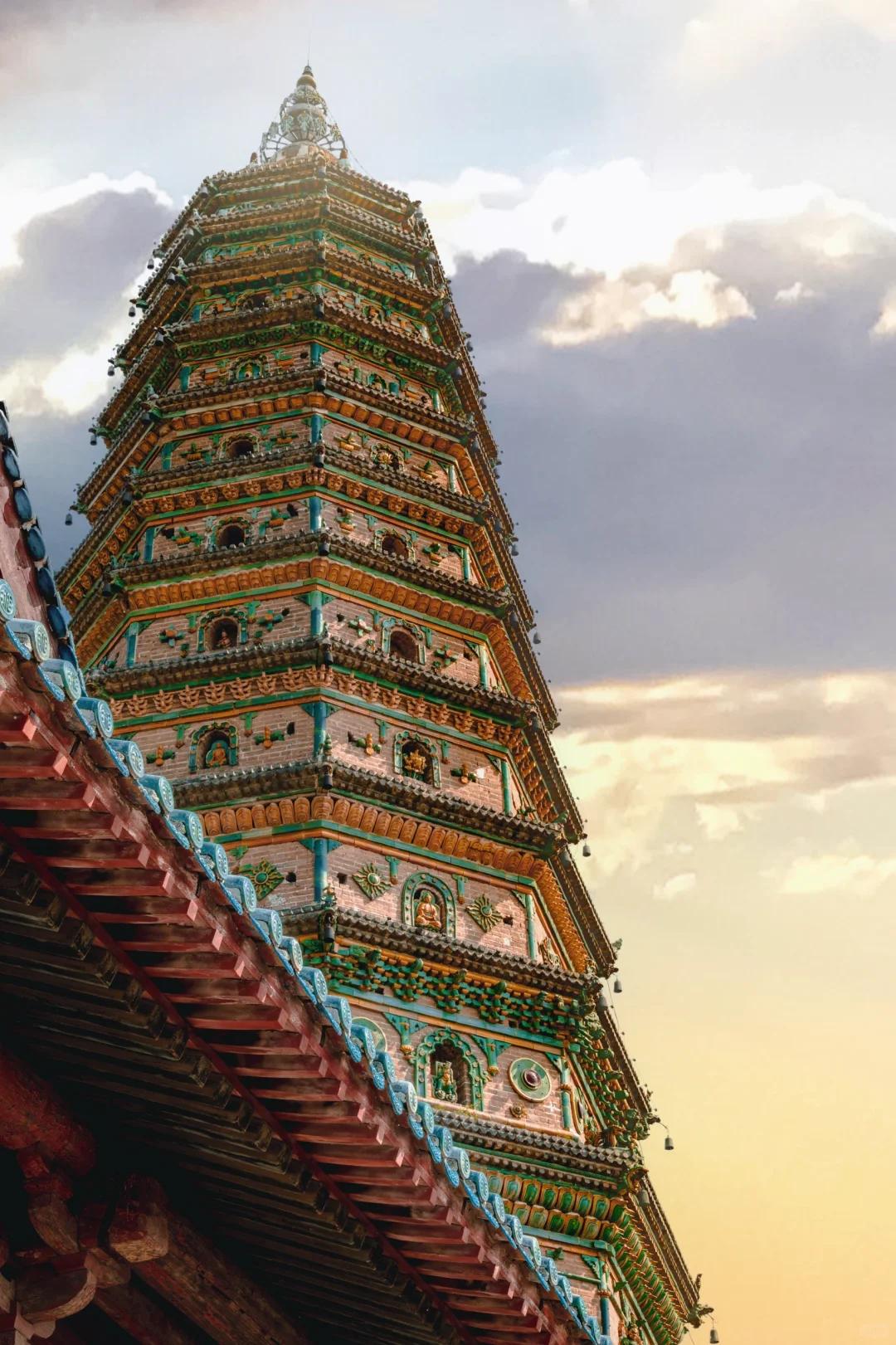
Guangsheng Temple.
3. Murals of Cultural Significance
Inside the Feihong Pagoda, you’ll find remarkable murals that tell stories of Buddhist teachings and local folklore. These colorful depictions are not just art; they are a vital part of the temple’s cultural heritage and provide insight into the spiritual life of ancient China. Spend some time observing the details, as these murals represent a precious legacy of ancient Chinese mural art.
4. The Great Hall: Center of Devotion
The lower section of the temple, known for its Great Hall, is home to exquisite Buddha statues that attract both pilgrims and tourists. This serene space offers a glimpse into the devotional practices of Buddhism and serves as a perfect spot for reflection. Take a moment here to soak in the peaceful atmosphere and perhaps participate in a meditation session, experiencing the tranquility that the temple embodies.

Guangsheng Temple.
5. Scenic Surroundings and Cultural Activities
The temple is not only a site for historical exploration but also a place to engage in cultural activities. From Zen meditation sessions to various Buddhist rituals, visitors have the opportunity to immerse themselves in the rich spiritual traditions of the temple. Additionally, the stunning natural backdrop of Huoshan Mountain offers picturesque views, making it an ideal setting for photography and relaxation.
6. Accessibility and Visitor Information
Guangsheng Temple is conveniently located just 17 kilometers northeast of Hongdong County. While the hike to the temple can be a delightful experience, small vehicles are available for those who prefer a more comfortable journey. The temple is open daily from 7:00 AM to 7:00 PM and is a nominal fee to enter, making it accessible for all.
Visiting Guangsheng Temple is not just a trip to a historical site; it’s a journey through time that offers a profound understanding of Chinese culture and spirituality. Make sure to include this magnificent temple in your travel itinerary for an enriching experience that will leave a lasting impression.
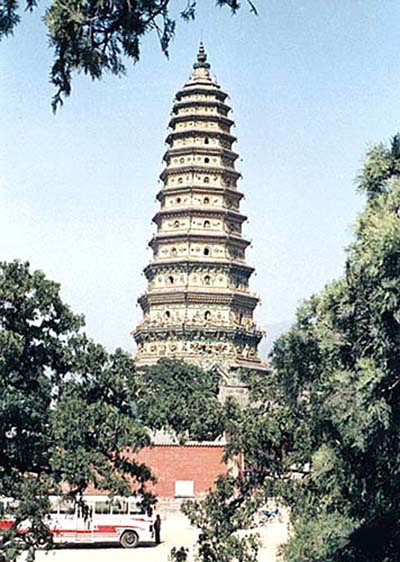
Guangsheng Temple.
Planning Your Visit: A Practical Guide
Essential Information for Your Visit to Guangsheng Temple
Nestled at the foot of Huoshan Mountain in Hongdong County, Guangsheng Temple is a treasure trove of Chinese history and culture, dating back to the Eastern Han Dynasty in 147 AD. This ancient Buddhist temple complex is not only renowned for its architectural beauty but also for its serene ambiance, making it a must-visit for any traveler interested in exploring China’s rich heritage.
Getting There
- Location: Guangsheng Temple is located approximately 17 kilometers northeast of Hongdong County, Shanxi Province.
- Transportation:
- By Car: If you’re driving, there’s parking available near the entrance.
- Public Transport: Local buses and taxis frequently operate from major points in Hongdong County to the temple.
- Walking: For those feeling adventurous, a short hike of around 15-20 minutes from the parking area leads you to the temple premises, providing beautiful views along the way.
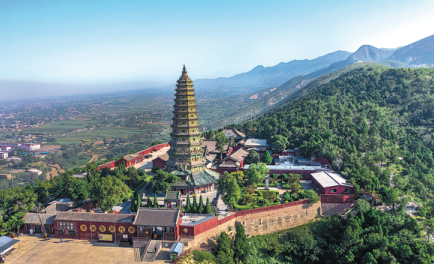
Guangsheng Temple.
Opening Hours
- Daily: 7:00 AM – 7:00 PM
Admission Fees
- Entrance Fee: Approximately 9.52 HKD (about $1.20 USD). Fees are subject to change, so it’s advisable to check through official channels before your visit.
Suggested Duration
- Plan to spend 2 to 3 hours exploring the temple complex. This allows ample time to appreciate the stunning architecture, including the famous Feihong Pagoda, participate in cultural activities, and soak in the tranquil environment.

Guangsheng Temple.
Key Attractions
-
Feihong Pagoda: The star attraction of Guangsheng Temple, this 13-storey octagonal pagoda is the largest and best-preserved glazed pagoda in China. Its vibrant colors glimmer beautifully under the sun, and the intricate murals inside narrate captivating Buddhist tales.
-
Upper and Lower Temples: The temple complex is divided into two parts. The upper temple, where the Feihong Tower is located, offers breathtaking views and a rich tapestry of murals. The lower temple features the Great Hall, home to exquisite Buddha statues and serene surroundings.
-
Cultural Activities: Visitors can engage in Zen meditation sessions, providing a unique opportunity to experience the spiritual essence of the temple.
Best Time to Visit
To fully enjoy the beauty of Guangsheng Temple, consider visiting in the spring or autumn. These seasons offer pleasant weather, ideal for both hiking and temple exploration. Early mornings or late afternoons are particularly enchanting, as the light casts a warm glow over the pagoda and surrounding landscape.
Nearby Attractions
While in the area, don’t miss the chance to explore other significant sites:
– Xia Temple (0.3 mi) – A stunning architectural site and religious landmark.
– Feihong Tower (1.5 mi) – An additional point of interest showcasing local history.
– Yuhuang Temple (1.2 mi) – Another beautiful religious site worth visiting.
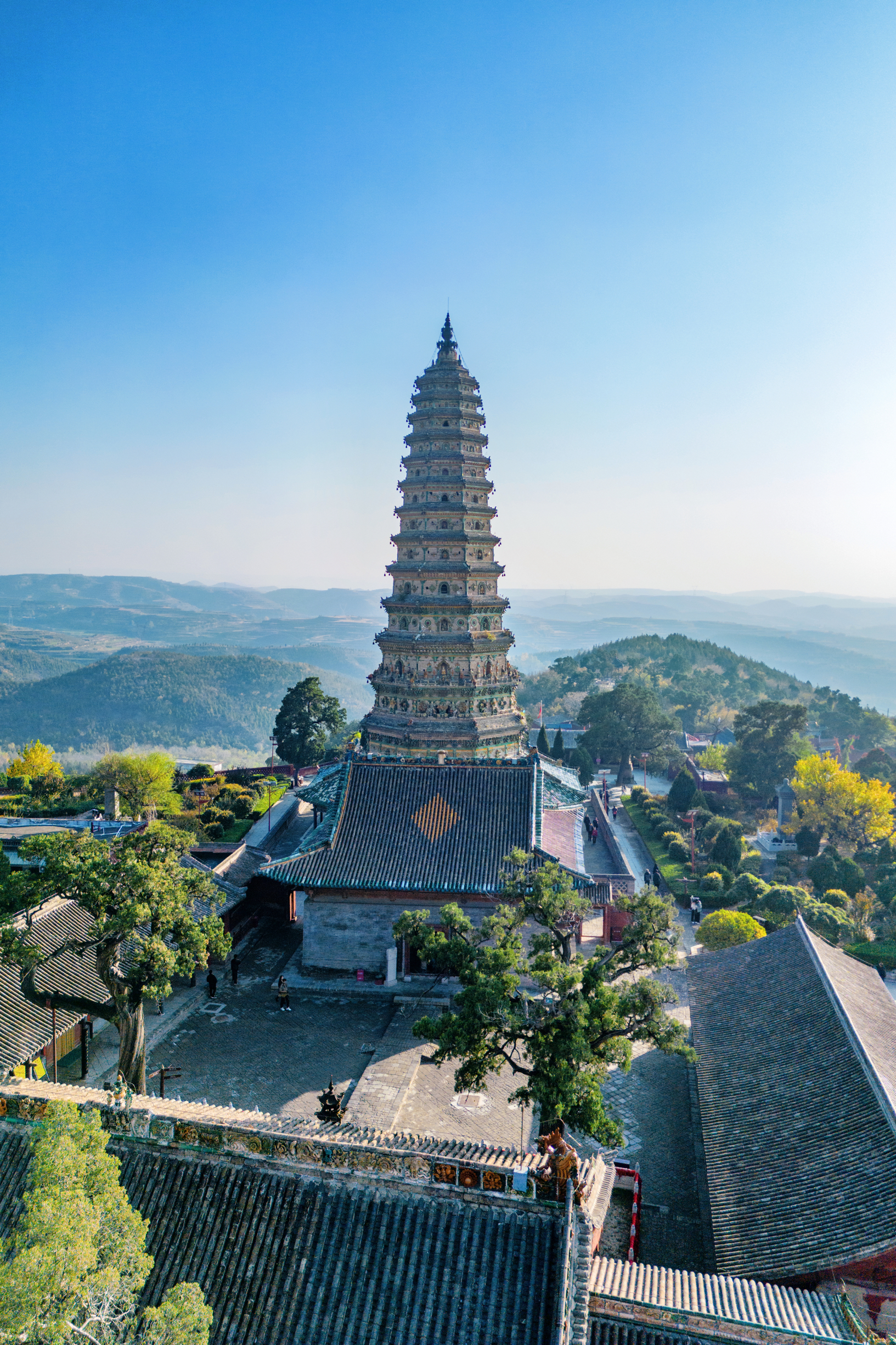
Guangsheng Temple.
Tips for Travelers
- Dress Modestly: As a place of worship, it’s respectful to wear modest clothing. Comfortable shoes are also recommended for exploring the temple grounds.
- Stay Hydrated: Bring water, particularly if you plan on hiking or visiting during warmer months.
- Photography: Don’t forget your camera! The intricate details and breathtaking views provide ample opportunities for spectacular photos.
Guangsheng Temple offers a unique glimpse into the spiritual and architectural heritage of China. Whether you are an avid historian, a cultural enthusiast, or simply seeking tranquility, this temple is sure to leave a lasting impression. Enjoy your visit!
Tickets: Prices, Booking, and Tips
When planning your visit to Guangsheng Temple in Hongdong County, it’s essential to be informed about ticket prices, booking options, and some helpful tips to enhance your experience.
Ticket Prices
Visiting Guangsheng Temple is quite affordable, making it accessible for travelers looking to immerse themselves in Chinese history and culture. The current ticket price is approximately HKD 9.52 (around USD 1.20), allowing you to explore one of China’s most significant Buddhist sites without breaking the bank.
Booking Information
While pre-booking is not strictly necessary due to the temple’s manageable visitor capacity, it can be beneficial during peak travel seasons or holidays. Here’s how you can secure your visit:
- On-site Purchase: Tickets can be purchased directly at the entrance. It is advisable to arrive early in the day to avoid crowds and fully appreciate the serene atmosphere.
- Online Booking: If you prefer the convenience of planning ahead, check popular travel platforms like Trip.com or Viator, which may offer ticketing options along with guided tours of the temple and its surrounding attractions.
Visiting Hours
Guangsheng Temple welcomes visitors every day from 7:00 AM to 7:00 PM. To make the most of your visit, consider arriving early in the morning or later in the afternoon, as these times typically see fewer tourists.
Tips for Your Visit
-
Plan for Walking: The temple complex is divided into two parts—the upper and lower temples, which are over 500 meters apart. Be prepared for a bit of a hike, especially to the upper temple where the stunning Feihong Pagoda is located. Comfortable walking shoes are highly recommended.
-
Photography: The temple is a photographer’s paradise, especially the Feihong Pagoda, known for its vibrant colors and stunning architecture. Aim to capture the pagoda in the morning light for the best visual impact.
-
Cultural Activities: Take the opportunity to participate in Zen meditation sessions often held at the temple. This experience not only deepens your understanding of Buddhist culture but also provides a tranquil escape from the bustling world outside.
-
Stay Hydrated: Given the walking and potential warmth, especially in the summer months, make sure to carry water with you to stay refreshed during your exploration.
By keeping these ticketing details and tips in mind, you can ensure a memorable and enriching visit to Guangsheng Temple, a true gem in China’s cultural landscape.
How to Get There: A Complete Transportation Guide
Getting to Guangsheng Temple: Your Comprehensive Transportation Guide
Nestled at the southern foot of Huoshan Mountain in the scenic Hongdong County of Shanxi Province, Guangsheng Temple (广胜寺) is a breathtaking destination for those interested in Chinese history and culture. Known for its exquisite architecture and rich heritage, the temple features the stunning Feihong Pagoda, a highlight not to be missed. Here’s your guide on how to reach this historical gem.
1. By Air
The nearest airport to Guangsheng Temple is Linfen Qiaoli Airport (LFQ), which is approximately 30 kilometers away. This airport mainly serves domestic flights, so you may need to connect through major Chinese cities like Beijing or Xi’an.
- From the Airport to the Temple:
- Taxi: The most convenient option, taxis are available outside the terminal. A ride to Guangsheng Temple takes about 40 minutes.
- Car Rental: If you prefer to drive yourself, several car rental services are available at the airport.
2. By Train
For those traveling from larger cities, the Linfen Railway Station is the closest major station. It connects with several high-speed rail lines and regional trains.
- From Linfen Railway Station to Guangsheng Temple:
- Taxi: This is the simplest and quickest way, taking around 30 minutes.
- Public Bus: Take bus route No. 3 or No. 6 towards Hongdong County. Once in Hongdong, you can take a local taxi or walk to the temple, which is about 17 kilometers northeast.
3. By Bus
Long-distance buses operate frequently from major cities in Shanxi Province to Hongdong County.
- From Taiyuan: Buses leave from the Taiyuan West Bus Station and take about 3 hours to reach Hongdong.
-
From Linfen: Local buses run every 30 minutes, making the journey to Hongdong quick and affordable.
-
Final Leg to the Temple:
- Once in Hongdong County, you can take a taxi for the final 17 kilometers to the temple, or look for local mini-vans that may offer rides to the site.
4. By Car
If you’re up for a road trip, renting a car gives you the flexibility to explore the stunning landscapes of Shanxi Province at your own pace.
- Driving Directions:
- From Taiyuan, take the G55 highway toward Linfen, then follow the signs to Hongdong County. The temple is clearly marked at the foot of Huoshan Mountain.
5. Local Transportation Options
Once at Guangsheng Temple, the site is divided into the upper and lower temples, which are over 500 meters apart.
- Hiking: A scenic hike connects the two areas and takes about 15-20 minutes. It is an enjoyable way to experience the natural beauty surrounding the temple.
- Taxi or E-Bike: For those who prefer not to hike, local taxis or e-bikes can often be hired for a small fee.
Conclusion
Reaching Guangsheng Temple is an adventure in itself, offering various modes of transportation that cater to different travel styles. Whether you’re flying in from afar, taking a scenic train ride, or driving through the picturesque Shanxi countryside, the journey will lead you to one of China’s architectural treasures. Prepare to immerse yourself in the tranquility and history of this magnificent site!
Local Cuisine and Accommodation Nearby
When planning your visit to Guangsheng Temple, not only can you immerse yourself in the rich history and stunning architecture of this ancient site, but you can also indulge in local culinary delights and enjoy comfortable accommodations nearby. Here’s a guide to help you make the most of your trip.
Savoring Local Flavors
1. Shanxi Noodles (刀削面 – Dao Xiao Mian)
One of the must-try dishes in the region is the famous Shanxi noodles. Hand-sliced and often served in a rich broth with various toppings, these noodles showcase the culinary traditions of the province. Look for local eateries near the temple that serve this dish.
2. Jinzhong Roast Duck (晋中烤鸭)
Similar to the more famous Beijing roast duck, Jinzhong roast duck is known for its crispy skin and tender meat. Enjoy it with traditional pancakes and hoisin sauce at restaurants in Hongdong County.
3. Aged Vinegar (陈醋)
Shanxi is renowned for its vinegar, particularly the aged variety. It’s a staple condiment in local dishes and can be found in many restaurants. Be sure to sample it with dumplings or as a dipping sauce.
4. Steamed Buns (包子 – Baozi)
These fluffy steamed buns, often filled with pork or vegetables, are perfect for a quick snack as you explore the area. They can be found at street stalls or small dining establishments.
Accommodation Options
1. Huoshan Mountain Hotel
Located conveniently close to Guangsheng Temple, this hotel offers comfortable rooms with stunning views of the surrounding mountains. Guests enjoy modern amenities, and the hotel’s restaurant serves local dishes, making it a great base for your explorations.
2. Linfen International Hotel
A short drive from the temple, this hotel provides a blend of luxury and comfort. With spacious rooms, comprehensive facilities, and a restaurant that features both local and international cuisine, it is ideal for travelers seeking a more upscale experience.
3. Hongdong County Guesthouse
For those looking for budget-friendly accommodations, this guesthouse offers clean and simple rooms. Its central location makes it easy to access local attractions, including the temple and nearby dining options.
4. Boutique Homestays
Immerse yourself in local culture by staying at a boutique homestay. These accommodations often feature traditional architecture and provide a personalized experience, allowing you to connect with local families and learn more about Shanxi culture.
Conclusion
Your visit to Guangsheng Temple can be enriched by exploring the local cuisine and enjoying comfortable accommodations. Whether you indulge in the delightful flavors of Shanxi or relax in a cozy hotel, you’ll create lasting memories of this culturally rich region. Enjoy your journey through history, culture, and gastronomy!
Frequently Asked Questions
Frequently Asked Questions about Guangsheng Temple
1. What is Guangsheng Temple and its historical significance?
Guangsheng Temple, built in 147 AD during the Eastern Han Dynasty, is one of the oldest and most significant Buddhist temples in south-central Shanxi Province, China. It is renowned for its exquisite architecture, especially the Feihong Pagoda, which is the largest and best-preserved glazed pagoda in China.
2. Where is Guangsheng Temple located?
The temple is situated at the southern foot of Huoshan Mountain, approximately 17 kilometers northeast of Hongdong County, Shanxi Province. Its picturesque setting adds to its appeal as a cultural and historical site.
3. What are the main attractions within the temple complex?
The temple is divided into two main parts: the upper and lower temple. The upper temple features the stunning Feihong Tower, known for its unique architectural style and vibrant murals depicting Buddhist stories. The lower temple centers around the Great Hall, which houses impressive Buddha statues. Visitors can also admire well-preserved colored glaze buildings from the Yuan Dynasty.
4. How long should I plan to spend at Guangsheng Temple?
A visit typically takes about 2 to 3 hours. This allows ample time to explore both the upper and lower temple, appreciate the architecture, and participate in cultural activities.
5. Are there any special activities or experiences available at the temple?
Yes! Visitors can engage in Buddhist cultural activities, including Zen meditation sessions. These experiences provide a unique opportunity to connect with the spiritual essence of the temple and enjoy moments of tranquility.
6. What are the operating hours for Guangsheng Temple?
Guangsheng Temple is open daily from 7:00 AM to 7:00 PM, allowing visitors to explore the temple throughout the day.
7. Is there an entrance fee to visit Guangsheng Temple?
Yes, the entrance fee is approximately HKD 9.52 (about USD 1.20), making it quite accessible for international travelers.
8. How do I get to Guangsheng Temple?
Visitors can reach Guangsheng Temple by public transportation, taxis, or private cars. For those traveling by coach, a short hike of about 15-20 minutes may be required to access the temple complex, although small vehicles can take you closer for an additional fee.
Final Thoughts on Your Trip
As your journey through the rich tapestry of Chinese history and culture draws to a close, Guangsheng Temple stands out as a profound testament to the nation’s architectural brilliance and spiritual depth. Nestled at the foot of Huoshan Mountain in Shanxi Province, this ancient temple offers an immersive experience that is both enlightening and calming.
A Living Heritage
Constructed during the Eastern Han Dynasty, Guangsheng Temple is not merely a relic of the past but a vibrant hub of Buddhist culture. The temple’s Feihong Pagoda, with its striking 13 stories and shimmering glazed tiles, is a breathtaking sight that encapsulates centuries of artistic endeavor and devotion. As you wander through its hallowed halls, you’ll encounter intricate murals and statues that tell stories of Buddhist teachings and local folklore, each whispering secrets of a rich cultural heritage.
Embrace the Serenity
The temple complex is divided into two distinct areas—the upper and lower temples—each offering unique experiences. The upper temple, dominated by the Feihong Tower, invites you to reflect on the tranquil beauty of your surroundings, while the lower temple, with its Great Hall, provides a space for spiritual contemplation and connection. Whether you choose to engage in Zen meditation or simply soak in the serene atmosphere, the temple offers a reprieve from the hectic pace of modern life.
An Invitation to Explore
Guangsheng Temple is not just a destination for history enthusiasts; it is a place for anyone seeking a deeper understanding of Chinese culture. The well-preserved architecture and the rich tapestry of life within its walls create an environment where every corner invites exploration and reflection. As you prepare to leave this magnificent site, take a moment to appreciate the harmonious blend of nature, art, and spirituality that defines Guangsheng Temple.
Final Reflections
In closing, your visit to Guangsheng Temple is more than a mere excursion; it is an opportunity to engage with a living history that continues to inspire. Allow the stories of the past to resonate within you, and carry the peace and beauty of this sacred space into your own life. As you venture forth, remember that every journey through China is a chance to connect with its enduring legacy, and Guangsheng Temple is a jewel in that vast tapestry. Safe travels!